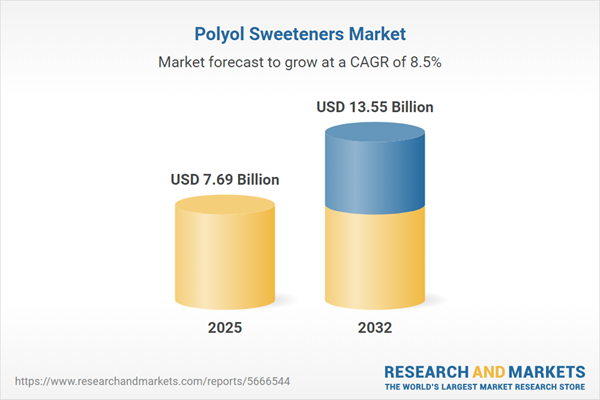Speak directly to the analyst to clarify any post sales queries you may have.
The polyol sweeteners market is experiencing notable transformation, driven by health-conscious consumer trends, shifting regulatory requirements, and increased cross-industry demand for flexible, reliable sweetener solutions. Senior executives seeking strategic insight will benefit from actionable, up-to-date intelligence that reflects sector innovation and operational complexities.
Market Snapshot: Polyol Sweeteners Market
In 2024, the polyol sweeteners market reached USD 7.08 billion in valuation, underpinned by a compound annual growth rate (CAGR) of 8.45%. The market is forecasted to achieve USD 13.55 billion by 2032, illustrating sustained expansion as businesses adapt to increasing demand for healthier ingredients. Consumer focus on reduced-calorie and low-glycemic food choices is reshaping product development, while manufacturers enhance supply chain coordination and adopt advanced production technologies to stimulate industry growth. Expansion in the Americas, Europe, and Asia-Pacific signals both opportunity and heightened market complexity as organizations navigate local and international regulatory developments.
Scope & Segmentation: Polyol Sweeteners Market Overview
- Product Types: Erythritol, isomalt, maltitol, mannitol, sorbitol, and xylitol are utilized to tailor calorie content, adjust sweetness, and improve texture for targeted formulations across food, feed, and specialty applications.
- Applications: Polyol sweeteners play a critical role in bakery, beverage, animal feed, confectionery, dairy, cosmetics, skin care, oral care, and pharmaceutical products, supporting expanded innovation and facilitating market entry into both traditional and emerging product categories.
- Form Factors: Granule, powder, and liquid formats empower bulk production and enable customization for diverse process needs, accommodating both mass-market scale and highly specialized product demands.
- Distribution Channels: Supermarkets, hypermarkets, convenience stores, B2B distributor networks, and online platforms form a robust route-to-market, ensuring access for large industrial customers, niche producers, and sector-specific buyers with varying sourcing requirements.
- Regional Coverage: The United States, Canada, major European economies, China, and India lead regional market expansion, as regulatory support and investor interest drive sustainable growth initiatives and internationalization strategies.
- Noteworthy Companies: Cargill, Archer-Daniels-Midland, Roquette Frères, Ingredion, International Flavors & Fragrances, Jungbunzlauer Suisse, Mitsubishi Gas Chemical, Lonza Group, Merck KGaA, and Gulshan Polyols are shaping sector benchmarks and advancing best practices in safety, quality, and technology.
Key Takeaways for Senior Decision-Makers
- The emergence of advanced polyol sweeteners offers extended application opportunities, particularly in non-food segments where properties such as low-glycemic impact and digestive benefits are valued for product differentiation.
- Biotechnology and next-generation process control are strengthening supply chain transparency, enabling organizations to identify risks and respond rapidly to disruptions or shifts in supply-demand dynamics.
- Product versatility allows manufacturers to realign offerings with evolving customer demands in sectors ranging from industrial to healthcare and personal care, underpinning organizational resilience and portfolio agility.
- Sustainable sourcing and process optimization are increasingly prioritized, encouraging environmental responsibility and alignment with current and emerging regulatory requirements across multiple geographies.
- Strategic partnerships and technology alliances are becoming central to achieving regulatory compliance, scaling operational capacity, and driving efficiency in both product development and distribution networks.
Assessing Tariff Impact: Supply Chain Adaptations and Market Resilience
Recent modifications to U.S. tariff policy have led stakeholders in the polyol sweeteners market to re-examine procurement and supplier management strategies. Enhanced supplier diversification and proactive logistics analysis are improving risk mitigation. By adopting flexible trade management policies, organizations demonstrate greater resilience, supporting business continuity through changing regulatory or economic conditions.
Methodology & Data Sources
This study integrates direct executive interviews, specialized supply chain insights, peer-reviewed research, patent analysis, and continual updates on global regulatory shifts. The approach ensures leadership receives findings aligned with strategic planning, supporting clear, informed decision-making within the polyol sweeteners market.
Why This Report Matters
- Presents an in-depth assessment of polyol sweeteners market dynamics and segmentation, equipping senior management to accurately identify both risks and growth prospects.
- Delivers guidance for business model innovation, emerging technologies, and compliance with shifting regulatory frameworks, enabling forward-looking planning and operational agility.
- Supports investors and corporate operators through recommendations that reflect actionable, region-specific insights for competitive and sustainable positioning.
Conclusion
This report supplies senior executives with targeted, data-driven intelligence to support robust strategic planning and agile responses as the polyol sweeteners market evolves amid new consumer, technological, and regulatory influences.
Additional Product Information:
- Purchase of this report includes 1 year online access with quarterly updates.
- This report can be updated on request. Please contact our Customer Experience team using the Ask a Question widget on our website.
Table of Contents
3. Executive Summary
4. Market Overview
7. Cumulative Impact of Artificial Intelligence 2025
Companies Mentioned
The companies profiled in this Polyol Sweeteners market report include:- Cargill, Incorporated
- Archer-Daniels-Midland Company
- Roquette Frères
- Ingredion Incorporated
- International Flavors & Fragrances Inc.
- Jungbunzlauer Suisse AG
- Mitsubishi Gas Chemical Company, Inc.
- Lonza Group AG
- Merck KGaA
- Gulshan Polyols Limited
Table Information
| Report Attribute | Details |
|---|---|
| No. of Pages | 191 |
| Published | November 2025 |
| Forecast Period | 2025 - 2032 |
| Estimated Market Value ( USD | $ 7.69 Billion |
| Forecasted Market Value ( USD | $ 13.55 Billion |
| Compound Annual Growth Rate | 8.4% |
| Regions Covered | Global |
| No. of Companies Mentioned | 11 |









